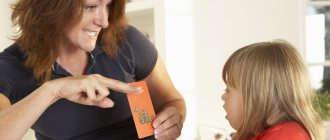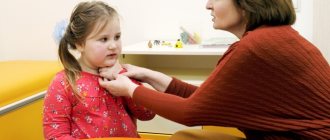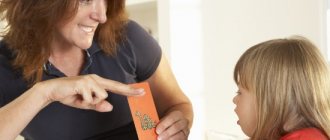The state of general speech underdevelopment (GSD) is characterized by a violation of all aspects of the formation of speech skills.
Its main distinguishing feature is the presence of problems both with the sound side (pronunciation), and with lexical and grammatical aspects. At the same time, children with general speech underdevelopment do not have hearing or intellectual impairments. Distinctive features of OHP:
- The presence of problems both with the pronunciation of sounds and with the skills of coherent expressive speech, mastering the rules of grammatical structure and a poor active vocabulary.
- Hearing is not impaired. A specialist check is required.
- Primary intelligence is normal. That is, a child at birth does not have a diagnosis of “mental retardation,” etc. However, it is worth keeping in mind that long-term uncorrected mental retardation can also lead to mental retardation.
It is possible to talk about the presence of general speech underdevelopment in a child only after 3-4 years. Until this time, children develop differently and “have the right” to some deviations from average norms. Everyone has their own pace of speech formation. But after 3, it’s worth paying attention to how the child speaks. It is quite possible that he needs the help of a speech therapist.
The manifestation of OHP in children is expressed differently based on their depth of impairment.
General speech underdevelopment level 1
A violation of this degree means an almost complete absence of speech in the child. Problems are visible to what is called the “naked eye.”
What does it show:
- A child's active vocabulary is very poor. To communicate, he uses mainly babbling words, the first syllables of words, and onomatopoeia. At the same time, he is not at all averse to communicating, but in “his” language. A cat means “meow”, “beep” can mean a car, a train, or the process of driving itself.
- Gestures and facial expressions are widely used. They are always appropriate, carry a specific meaning and, in general, help the child communicate.
- Simple sentences either simply do not exist in the child’s speech, or may consist of two amorphous words combined in meaning. “Meow bee bee” during the game will mean that the cat drove the car. “Woof di” means both the dog is walking and the dog is running.
- At the same time, the passive vocabulary significantly exceeds the active one. The child understands spoken speech to a much greater extent than he can say himself.
- Compound words (consisting of several syllables) are abbreviated. For example, bus sounds like "abas" or "atobu". This indicates that phonemic hearing is unformed, that is, the child does not distinguish individual sounds well.
Prevention
Diagnosing a child with ODD does not mean that this disorder cannot be eliminated. Timely and correct correction, compliance with all recommendations of speech therapists and doctors often provides a good result, in which the baby’s speech becomes coherent and understandable until it fully complies with the age norm. Associated violations in this case are also corrected.
Prevention of OHP in children is, first of all, following all doctor’s recommendations during pregnancy, childbirth and the first years of the baby’s life, reducing the risk of injury and regular developmental activities, talking with the child, reading books. It is also important to promptly consult a specialist at the first signs of speech impairment.
If you have any doubts about your baby's speech, do not worry ahead of time. Doctors and speech therapists at the SM-Doctor clinic will conduct the necessary tests and diagnostics, and, if necessary, draw up a program of corrective measures.
General speech underdevelopment level 2
The main striking difference from level 1 is the constant presence in the child’s speech of a certain number of commonly used words, although not yet pronounced very correctly. At the same time, the beginnings of the formation of a grammatical connection between words are noticeable, although not yet permanent.
What to pay attention to:
- The child always uses the same word, denoting a specific object or action in a distorted form. For example, apple will always sound like “lyabako” in any context.
- The active dictionary is quite poor. The child does not know words denoting the characteristics of an object (shape, its individual parts).
- There is no skill in combining objects into groups (a spoon, plate, pan are utensils). Objects that are similar in some way can be called in one word.
- Sound pronunciation is also far behind. The child pronounces many sounds poorly.
- A characteristic feature of level 2 OHP is the appearance in speech of the rudiments of a grammatical change in spoken words depending on the number. However, the child can only cope with simple words even if the ending is stressed (go - goUt). Moreover, this process is unstable and does not always manifest itself.
- Simple sentences are actively used in speech, but the words in them are not consistent with each other. For example, “papa pitya” - dad came, “guyai gokam” - walked on the hill, etc.
- Prepositions in speech may be completely missed or used incorrectly.
- A coherent story - based on a picture or with the help of an adult's questions - is already obtained, in contrast to the state at level 1 OHP, but it is very limited. Basically, the child uses two-syllable, inconsistent sentences consisting of a subject and a predicate. “Guyai gokam. Videy seg. Ipiy segika." (Walked on a hill, saw snow, made a snowman).
- The syllabic structure of polysyllabic words is disrupted. As a rule, syllables are not only distorted due to incorrect pronunciation, but also rearranged and simply thrown out. (Boots are “bokiti”, people are “tevek”).
As can be seen from Diagram 4, children’s active and passive vocabulary is enriched by nouns and verbs. But in the process of verbal communication, there is often an inaccurate selection of words, which results in verbal paraphasias (chair - “sofa”, knit - “weave”).
Children at level III of speech development use mainly simple sentences in their speech. When using complex sentences expressing temporal, spatial, cause-and-effect relationships, pronounced violations appear.
Characteristic for level III are inflection disorders. In children's speech, there are a large number of coordination and control errors. The most common errors are the following: incorrect use of some forms of plural nouns (“chairs”, “ears”, “brothers”), confusion of endings of masculine and feminine nouns in indirect cases (“hanging a nut”), replacement of endings of neuter nouns in nominative case with the ending of feminine nouns (hoof - “hooves”, trough – “trough”), declension of neuter nouns as feminine nouns (“shepherds the herd”, “killed a hoof”), incorrect case endings of feminine words with a stem on soft consonant (“salts salt”, “no furniture”), erroneous stress in the word, violation of differentiation of the type of verbs (“sat down until the rain stopped”), errors in non-prepositional and prepositional control (“drinks water”, “puts firewood” ), incorrect agreement between noun and adjective, especially in the neuter gender (“the sky is blue”).
At this level of speech development, word formation disorders are also observed. These disorders manifest themselves in difficulties in differentiating related words, in a lack of understanding of the meaning of word-forming morphemes, and in the inability to complete word formation tasks.
The sound aspect of the speech of children at level III of speech development significantly improves compared to levels I and II. The blurriness and diffuseness of the pronunciation of articulatory complex sounds disappears. Only disturbances of some articulatory complex sounds remain. The syllabic structure is reproduced correctly, but there are still distortions in the sound structure of polysyllabic words with a combination of consonants (frying pan - “kovorora”, bicycle - “sipeped”). Distortions of the sound-syllable structure appear mainly when reproducing unfamiliar words.
Phonemic development is characterized by a lag.
Children with developmental disabilities differ from their normally developing peers in the characteristics of their mental processes. They are characterized by: instability of attention, decreased verbal memory and memorization productivity, and a lag in the development of verbal and logical thinking. The listed features lead to the inability to timely engage in educational and gaming activities or switch from one object to another. They are characterized by rapid fatigue, distractibility, and increased exhaustion, which leads to various types of errors when performing tasks.
Many children with OHP levels II and III have motor impairments in the articulatory apparatus: changes in muscle tone in the speech muscles, difficulties in fine articulatory differentiation.
Speech disorders are closely associated with impaired fine motor skills of the hands: insufficient coordination of fingers, slowness and awkwardness of movements, getting stuck in one position.
These deviations in the development of children suffering from levels II and III ODD are not spontaneously overcome. They require specially organized work to correct them.
Thus, OHP is often a consequence of the complex influence of various factors: organic, psychogenic, social. Level II of speech development is characterized by the fact that children begin to use speech means more extensively, but nevertheless, gross deviations from the norm are noted in the development of the phonetic-phonemic system and lexical-grammatical structure. Level III of speech development is characterized by the absence of gross deviations in the development of phonetic-phonemic and lexical-grammatical aspects of speech. Children with ODD levels II and III differ from their normally developing peers in the characteristics of mental processes: memory, attention, thinking.
References:
- Beltyukov V.I. Interaction of analyzers in the process of perception and assimilation of oral speech. – M.: Pedagogy, 1977.
- Gvozdev A. N. Issues in the study of children's speech. – M.: publishing house of the Academy of Pedagogical Sciences of the RSFSR, 1961.
- Zhinkin N. I. Grammar and meaning // In the book: Language and man. – Vol. 4. – M.: Moscow State University Publishing House, 1970.
- Zhukova N. S., Mastyukova E. M., Filicheva T. B. Overcoming ODD in preschool children. – M.: Education, 1973.
- Leontyev A. A. Fundamentals of the theory of speech activity. – M.: Pedagogy, 1974.
- Speech therapy / Ed. L. S. Volkova. – M.: Vlados, 2002.
- Lopatina L.V. Speech therapy work with preschool children. – St. Petersburg: Soyuz, 2004.
- Mukhina V. S. Age psychology. – M.: Academy, 2000.
- Nemov R.S. Psychology. Book 1, 2. – M.: Vlados, 2001.
- Prishchepova I.V. Speech development of junior schoolchildren. – St. Petersburg: KARO, 2005.
- Speech activity in normal and pathological conditions: Proceedings of an interdisciplinary scientific and methodological conference. – St. Petersburg: publishing house of the Russian State Pedagogical University named after. A. I. Herzen, 1999.
- Systemic speech disorders: Alalia, Aphasia / Ed. L.S. Volkova. – M.: Vlados, 2003.
- Filicheva T. B., Cheveleva N. A., Chirkina G. V. Fundamentals of speech therapy. – M.: education, 1989.
- Phonetic-phonemic and general speech underdevelopment. Book 5 / Ed. L.S. Volkova. – M.: Vlados, 2003.
- Khvattsev M. E. Speech therapy. Working with preschoolers. – St. Petersburg: Delta, 1996.
Compiled by: teacher-speech therapist GBOU CPPRiK Ivanova Elena Anatolyevna
General speech underdevelopment level 3
This stage is characterized mainly by a lag in terms of grammatical and phonemic development of speech. Expressive speech is quite active, the child constructs detailed phrases and uses a large vocabulary.
Problem points:
- Communication with others is mainly in the presence of parents, who act as assistant translators.
- Unstable pronunciation of sounds that the child has learned to pronounce separately. In independent speech they still sound unclear.
- Sounds that are difficult to pronounce are replaced by others. Whistling, hissing, sonorant and affricates are more difficult to master. One sound can replace several at once. For example, the soft “s” often plays different roles (“syanki” - sledge, “syuba” - “fur coat”, “syapina” - “scratch”).
- The active vocabulary is noticeably expanding. However, the child does not yet know the little-used vocabulary. It is noticeable that in his speech he uses mainly words of everyday meaning, which he often hears around.
- The grammatical connection of words in sentences, as they say, leaves much to be desired, but at the same time the child confidently approaches the construction of complex and complex constructions. (“Papa wrote and pyinesya Mise padaik, how Misya haase behave yourself” - Dad came and brought Misha a gift, BECAUSE Misha behaved well. As we see, a complex construction is already “asking for the tongue”, but the grammatical agreement of words is not yet given ).
- From such incorrectly formed sentences, the child can already compose a story. Sentences will still only describe a specific sequence of actions, but there will no longer be a problem with constructing phrases.
- A characteristic feature is the inconsistency of grammatical errors. That is, in one case, a child can correctly coordinate words with each other, but in another, use the wrong form.
- There are difficulties in correctly agreeing nouns with numerals. For example, “three catsAM” - three cats, “many sparrows” - many sparrows.
- The lag in the formation of phonemic abilities is manifested in errors when pronouncing “difficult” words (“gynasts” - gymnasts), in the presence of problems in analysis and synthesis (the child finds it difficult to find words starting with a specific letter). This, among other things, delays the child’s readiness to succeed in school.






